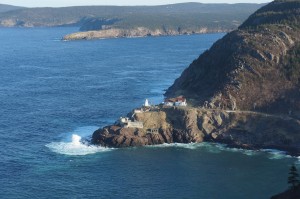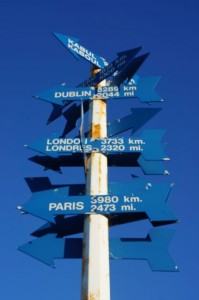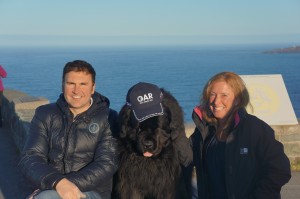Sobering Statistics
Yesterday I was sitting in Bojangles’ shed with Naomi and Mos (and Bo, of course) as we discussed our safety strategies. This is top of our minds – and for good reason. If you go to the Ocean Rowing Society website, the little box at the bottom of the page that sums up the stats on Atlantic rows from West to East reads like this:
Completed: 19
Incomplete: 33
Rowers lost at sea: 5
These are sobering statistics.
Even though the Newfoundlanders have been more than living up to their reputation for friendliness and hospitality, apparently in some quarters there have been mutterings about crazy adventurers heading out on hare-brained missions, only to fail and need rescuing to the great inconvenience, cost, danger, and understandable disgruntlement of the locals.

Later that day Mos, Naomi and I went to take a look at the ocean. Naomi drove us to the top of Signal Hill, at the mouth of St John’s Harbour. It was a beautiful day, with hazy sunshine and barely a breath of wind. As we stepped out of the car our high vantage point gave us an excellent view of the vast expanse of limpid ocean stretching away below us.
At first glance it was a gorgeous sight. With no white caps, the ocean looked almost inviting. But as we continued to look, it started to appear less friendly. A small fishing boat heading back to port laboured in the swell. Where the apparently calm sea met the land, it crashed with surprising force against the rocks at the narrow entrance to the harbour, sending up plumes of spray. Farther out to sea, a bank of fog stretched all the way across the horizon from left to right.
“Crikey,” said Mos. “Crikey. Gosh.” Which was quite restrained, I thought. Something less printable was going through my mind. Even on a perfect day like yesterday, the ocean’s power and size was inescapable.
The Good News
Having said all this, we have a better chance than most. Here are my reasons for not freaking out about our imminent embarkation upon the North Atlantic:

1. The boat: a lightweight kevlar boat with 200 pounds of lead in her hull to help stability, Bojangles has already proved her seaworthiness in challenging conditions during her 189-day voyage across the North Pacific. Mos now has the bit between his teeth and is working all the hours on Bojangles to ensure that she is even better prepared for this row. He is a real perfectionist. In this context, that is a very reassuring quality in a crewmate.
2. The crew: between us, Mos and I have logged over 580 days at sea, and covered over 18,000 miles. It is only 7 months since I got off the Indian Ocean, so my experience is still recent. Mos is 48 years old, and I am 44, so we are hardly hot-headed young turks. We both have a lot to live for – he has two young children and I have a place at Yale – and we will tap into that motivation when the going gets tough. Safety tops the list of priorities for both of us.
3. The team: two members of our support team have also rowed an ocean: program director Richard Mayon-White and UK project manager Rachel Smith. US project manager Naomi Coe is one of the most calm and competent people I have ever had the privilege to work with, and has been instrumental in getting us to the start line. Our weatherman Lee Bruce has weather-routed at least 10 ocean rowing voyages, including several out of St John’s.
But even so, I wanted to take another look at the statistics.
Only one pair has been lost at sea on the North Atlantic, David Johnston and John Hoare in the Puffin, who left from Virginia Beach in the USA in 1966. Cause presumed to be a hurricane. I read their book, The penance way: The mystery of Puffin’s Atlantic voyage, before I rowed the Atlantic. It seemed that they left before they were properly ready, forced into a race to beat Blyth and Ridgway who left at around the same time from Cape Cod.
The other three fatalities were all solos, one leaving from the US, two from Canada. Those two departures from Canada both happened in 1980, since when satellite phones, GPS, watermakers, improved weather forecasting and better boat design have all been factors in improving ocean safety. In fact, the Ocean Rowing Society differentiates between Historic Rows (pre-1982 and advent of new technologies) and Modern Day Rows (post-1982). As Gerard d’Aboville said of his Atlantic row and all ocean rows between 1896 and 1982: “We were like test pilots, but without a parachute”. Now, thank heavens, we have parachutes – or at least para-anchors.
Intrigued, with a very vested interest, in finding out what had happened to the other failed Modern Day Rows from Canada, I did some further digging:
Roy Finlay and Colleen Cronin (2000): towed back by Canadian Coastguard after 26 days. Roy Finlay had rowed the Atlantic E-W previously. Colleen had not rowed an ocean. They abandoned their attempt when headwinds and a brewing hurricane threatened progress. The winds subsequently changed for the better, but they had already turned back.
Matthew Boreham (1999): check out his website. Apparently abandoned due to delays in shipping.
Peter Bray (2009): rescued after 42 days when his boat capsized and failed to self-right. I’m guessing, but maybe the cabin hatch was open, or the boat was not correctly ballasted. Ocean rowboats are designed to be self-righting if capsized. It was his first ocean row.
Sean Moriarty (2011): rescued after 1 day 20 hours when his boat capsized repeatedly. Assuming that this article meant to say 15-foot boat rather than 15-metre boat, but is correct in saying 3-4 metre waves were responsible for the capsizes, it seem surprising that seas of this modest size could capsize his boat. With Bo’s greater size (7.1 metres) and lead ballast, I am sure that she will handle such conditions without difficulty. It was Sean Moriarty’s first ocean row.
Skandia Four (2002): recovered after 21 days when the rudder broke.
Pink Lady Four (2004): rescued after 38 days. Poor Peter Bray once again ended up in the drink when their boat broke in two in Hurricane Alex. It was also Jonathan Gornall’s second failed attempt. An ocean rowboat should not break, leading to speculation that the boat might have been damaged in transit, or overly modified from the original design, weakening its structure.
Conclusion
To put this in perspective, among the Modern Day Rows since 1982 there have been six successful rows from Canada (5 solo and 1 four) and six failed ones. Odds even. Of those six, two were due to capsizes, two to equipment failures, and two were voluntarily abandoned. The statistics are starting to look a lot better than they did at first. Bojangles was built by ex-marine Mick Dawson, and was built to last. Especially her rudder.
Better still, there have been no fatalities among the Modern Day departures from Canada – no doubt due to the valiant Canadian coasties, whom we sincerely hope, and conscientiously plan, not to trouble.

Latest News
We currently do not have a confirmed departure date, but are unlikely to leave before next Monday at the earliest. Brisk winds from an unhelpful quarter will keep us in St John’s for a few days yet.
To get the latest news from the OAR project, check us out:
And please consider donating to our chosen charity, the Rowing Foundation, to help get more youngsters out on the water, or chip in towards our satellite phone bill so we can continue to bring you these blogs from the ocean.
Thank you!

You have inspired us so much with your rowing solo around the world, Roz. You focused on the positive and what the universe presented to you. That much I learned from tracking your journeys – to be present and mindful of what is happening at the moment while keeping an eye as far as you can see. You did not give way to fears or doubts, to sadness or worries.
You also asked for help from us if you needed it, and we were right there to give you our energies, prayers and blessings. Yes, you would not be rowing alone much like before though this time you have raised the bar. You now have been presented an alternative future whereas before, you were in search of yourself.
If you could leave before May 14, that would be ideal. I trust your path to London would be a smooth one, and your journey a triumphant achievement.
Tenacity, skill, intelligence, overcomes the reliance on luck. All of which, you have ample quantities. Opportunity is only ballast for the in-between time. That being said…
“Great, kid. Don’t get cocky.” ~Han Solo
Row Roz Row!
Right on, Jay
Row Roz Row!!!
Roz, you never fail to astound me with your revealing insights into your thinking when undertaking such daunting ventures. Not are you only FULL of courage, you have the wonderful gift of being able to communicate your feelings with frankness and humour. Whilst the challenges you undertake are no doubt personally very rewarding, your use of such ventures to promote your concern for the environment is something beautiful. You are simply unique! The world is lucky to have you. ..a giant in a petite and charming disguise 🙂 Safe travels to you both. David Church
David, very well said … no need to echo, except to say that scientifically digging into the context and significance of superficial, simple statistics for full understanding touches my heart …
You and your analytical scientific approach touch my heart. Bon voyage!
Wow! Roz! WOW!
Good luck with everything and look forward to read your progress. May the winds be on your back all the way to the UK
The row of John Ridgway and Chay Blyth I remember as a tremendously inspiring achievement. There was no tweeting, sat phone or blogging then so there was great anticipation and news coverage when they made it. So I wish you inspiring achievements – little and big on your adventure.
Interestingly they threw a plastic container of excess water overboard. I wonder what remains of the plastic container?I have just read Plastiki, a wonderful book. It is not only about the journey from San Francisco to Australia in a boat made of plastic bottles. It also has lots of useful statistics and commentary about plastic in the ocean.